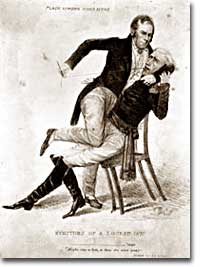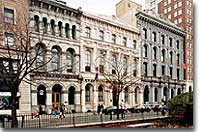24d. The War Against the Bank

Jackson's actions with regards to the Second Bank of the United States resulted in his censure by Congress for abuse of power. This cartoon depicts Henry Clay sewing Jackson's mouth shut.
The Second Bank of the United States was chartered in 1816 for a term of 20 years. The time limitation reflected the concerns of many in Congress about the concentration of financial power in a private corporation. The Bank of the United States was a depository for federal funds and paid national debts, but it was answerable only to its directors and stockholders and not to the electorate.
The supporters of a central bank were those involved in industrial and commercial ventures. They wanted a strong currency and central control of the economy. The opponents, principally agrarians, were distrustful of the federal government. The critical question — with whom would President Jackson side?

These buildings, known as Bankers Row, are across from the Second Bank of the United States. This financial center is sometimes called "America's first Wall Street."
At the time Jackson became President in 1828, the Bank of the United States was ably run by Nicholas Biddle, a Philadelphian. But Biddle was more an astute businessman than politician. His underestimation of the power of a strong and popular President caused his downfall and the demise of the financial institution he commanded.
Jackson had been financially damaged by speculation and a tightening of bank credit early in his business career. He retained a distrust of financial institutions throughout his life. At first, however, Jackson's position on the Bank was not outwardly antagonistic. He was concerned about the Bank's constitutionality and the general soundness of paper money in place of gold and silver ("hard money"). Jackson was also sympathetic to "soft-money" supporters from the west who wanted access to easy credit.
In January 1832, Biddle's supporters in Congress, principally Daniel Webster and Henry Clay, introduced Bank recharter legislation. Even though the charter was not due to expire for four more years, they felt that the current Congress would recharter the Bank. They felt that Jackson would not risk losing votes in Pennsylvania and other commercial states by vetoing it. Jackson reacted by saying to his vice-president, Martin Van Buren, "The Bank is trying to kill me, Sir, but I shall kill it!"
Jackson's opposition to the Bank became almost an obsession. Accompanied by strong attacks against the Bank in the press, Jackson vetoed the Bank Recharter Bill. Jackson also ordered the federal government's deposits removed from the Bank of the United States and placed in state or "Pet" banks. The people were with Jackson, and he was overwhelmingly elected to a second term. Biddle retaliated by making it more difficult for businesses and others to get the money they needed. This caused an economic contraction at the end of 1833 and into 1834. The bank charter expired in 1836.






